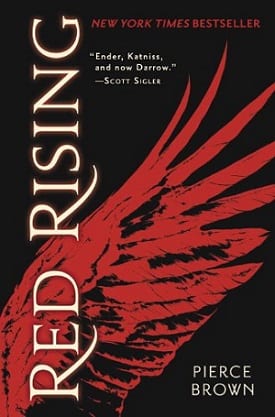 Written by Rich Rogers
Written by Rich Rogers
“Red Rising” by Pierce Brown
Del Rey, 2014. Hardcover, trade paperback, ebook, audiobook. 400 pages.

Darrow is from the mines of Mars. His family—in fact, all the Reds—have lived below the surface of the red planet for centuries, mining helium-3, the fuel necessary to terra-form Mars. He’s young, but he knows pain. Aside from the dangers of working in the mines—the huge drills, snakes, and many other things—as a young boy, he watched his father hung for treason.
The Martian society is arranged by caste based on your colors. Red are the miners at the very bottom. Other colors are Greys, the military/security; Browns, the servant class; Coppers, the bureacracy/administration; Pinks, the pleasure workers; Silvers, the innovators/businessmen; and the ruling class, the Golds.
When Darrow and his wife, Eo, are beaten publicly for crossing color boundaries and spending time in a Grey garden, Eo takes things one step further by singing a forbidden song and is hung for her act of rebellion. Again, Darrow is forced to watch. That’s a lot for 17 years old. His own act of rebellion in cutting down her body leads to his own public hanging.
But he doesn’t die.
Instead, he’s rescued by the Sons of Ares, a group dedicated to overthrowing the whole Martian order.
And that’s when he learns his life is a lie. Mars has been terra-formed for centuries, but the Reds are still being told the surface isn’t ready. On the surface are huge cities, woods, mountains, forests, rivers, and luxury beyond Darrow’s wildest dreams.
The Sons of Ares plan to destroy the society from within, and Darrow is their key. They make him a Gold, with all the genetic and physical engineering and manipulation—and pain—that go with it. Not to mention the education that Reds never received: history, literature, riding, manners, you name it.
Once that is done, they set him up for entrance into the Institute–a training ground for the Society’s best and brightest.
The Institute is a cross between Hogwarts and Ender Wiggins’ Battle School. Hogwarts only because the students are divided into houses, but there’s no Sorting Hat. As for the Battle School, the Institute is 50 times more deadly and dangerous, and the motives have nothing to do with protecting humanity, other than a single privileged group.
Darrow tries to stay true to his Red heritage, but surprises himself by often seeing good in Gold Society. As he comments near the end of the book, the Golds contain the best and the worst of humanity.
As the debut novel of Pierce Brown, “Red Rising” is powerful. Sometimes overpowering, the violence in the book is often over the top, but more troubling is the Society’s casual attitude toward it—just another facet of life you have to deal with. The violence is so brutal and simultaneously so casual that it’s often shocking. There are also times when Darrow seems a little too comfortable in his new role and forgetting his Red roots.
It took me a while to get fully into “Red Rising.” I think part of that is because it’s told in first person present, and that took me a while to get with the flow. But once I fell into the groove, it was a grand ride. I couldn’t put this down. One thing that does frustrate me here is simple: Why does every author have to write a trilogy? Who knows, maybe that wasn’t his intention at the start, but there are times I’d like to pick up a novel and know that I won’t have to wait for two more books to find out what happens to the hero. Take for example, Jim Butcher’s Harry Dresden series. Yes it’s a series, but you can read any book in the series as a stand alone. “Red Rising” is a great book and a stunning debut, but I am tired of trilogies all the time. Tolkien did such a good job with his that everyone and their pet dog wants to do one. Having said all that, I’ll say again, this is a book worth reading. Just don’t give it to younger readers; the violence is over the top.
Rich welcomes comments and questions from readers. You may contact him at [email protected].




